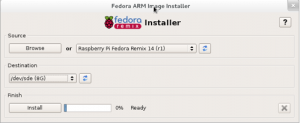"Official" Fedora Linux Remix for Raspberry Pi arrives

It took several weeks longer than planned, but the "recommended" Linux distribution for the Raspberry Pi, the credit-card sized computer that retails for $35, Raspberry Pi Fedora Remix is finally ready to run.
The distribution designer's Chris Tyler announced the release on March 7th, but the official release came on March 8th. This Linux distribution is based on Fedora 14. This distribution, along with versions of Debian and Arch Linux for the Raspberry Pi, are now available for download.
According to the Raspberry Foundation, "The Remix is a distribution comprised of software packages from the Fedora ARM project, plus a small number of additional packages that are modified from the Fedora versions or which cannot be included in Fedora due to licensing issues - in particular, the libraries for accessing the VideoCore GPU on the Raspberry Pi."
The operating system, which comes as an SD card image "includes a little over 640 packages, providing both text-mode and graphical interfaces (Lightweight X11 Desktop Environment (LXDE)/ XFCE) with an assortment of programming languages, applications, system tools, and services for both environments. There are over 16,000 software packages available from the Fedora ARM repositories which can be easily installed using the Internet to customize your system to meet your needs and interests (again, using either command-line or graphical tools)."
- Raspberry Pi Fedora Remix includes the following programs and packages:
- Programming languages: python, Perl, Ruby, bash
- Version control: git
- System administration tools (command line and/or graphical) for configuring various aspects of the system including the network, date/time, users, and printers
- Command-line and graphical tools for installing/removing/updating software
- ssh (secure remote login) and printer services
- Graphical applications: word processing (AbiWord), spreadsheets (Gnumeric), image editing (GIMP), and web browsing (Firefox)
- Editors for programming: vim (text mode) and gedit with plugins for file management, terminal, and python console (graphical mode)
Tyler wrote that the "The easiest way to install the Remix is to grab an installer, written by Jon Chiappetta:
Run the installer, plug in an SD card, click the refresh arrows to update the list of images and target devices, select the image you want (r1) and the SD card, then click Install.
The installer automates the process of downloading the image, decompressing it, and installing it onto an SD card. Once the system boots from the SD drive, you can then set it up. You can either run it as a PC or log into it via secure shell (ssh) and you can login with the default root password of "fedoraarm."
Looking ahead," the Fedora ARM project is hard at work building Fedora 17, which we hope to release concurrently with the PC versions in May. This should be the most complete Fedora ARM release produced to date. Students in the SBR600 course at Seneca College are working to on an improved version of the Remix incorporating files from Fedora ARM 17, and this will also be released in May."
Related Stories:
You can now run Arch & Debian Linux on a Raspberry Pi
What is a Raspberry Pi and why you should care
Raspberry Pi? Buying frenzy crashes website
Raspberry Pi: A $25 ultra-low-cost computer that can run Quake 3
Fedora 16, Red Hat's new community Linux distribution, arrives
